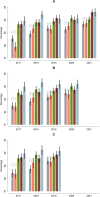The Danish Atrial Fibrillation Registry: A Multidisciplinary National Pragmatic Initiative for Monitoring and Supporting Quality of Care Based on Data Retrieved from Administrative Registries
- PMID: 38149081
- PMCID: PMC10750776
- DOI: 10.2147/CLEP.S443473
The Danish Atrial Fibrillation Registry: A Multidisciplinary National Pragmatic Initiative for Monitoring and Supporting Quality of Care Based on Data Retrieved from Administrative Registries
Abstract
Aim: The Danish Atrial Fibrillation (AF) Registry monitors and supports improvement of quality of care for all AF patients in Denmark. This report describes the registry's administrative and organizational structure, data sources, data flow, data analyses, annual reporting, and feedback between the registry, clinicians, and the administrative system. We also report the selection process of the quality indicators and the temporal trends in results from 2017-2021.
Methods and results: The Danish AF Registry aims for complete registration and monitoring of care for all patients diagnosed with AF in Denmark. Administrative registries provide data on contacts to general practice, contacts to private cardiology practice, hospital contacts, medication prescriptions, updated vital status information, and biochemical test results. The Danish Stroke Registry provides information on stroke events. From 2017 to 2021, the proportion with a reported echocardiography among incident AF patients increased from 39.9% (95% CI: 39.3-40.6) to 82.6% (95% CI: 82.1-83.1). The initiation of oral anticoagulant therapy among patients with incident AF and a CHA2DS2-VASc score of ≥1 in men and ≥2 in women increased from 85.3% (95% CI: 84.6-85.9) to 90.4% (95% CI: 89.9-91.0). The 1-year and 2-year persistence increased from 85.2% (95% CI: 84.5-85.9) to 88.7% (95% CI: 88.0-89.3), and from 85.4% (95% CI: 84.7-86.2) to 88.2% (95% CI: 87.5-88.8), respectively. The 1-year risk of ischemic stroke among prevalent patients with AF decreased from 0.88% (95% CI: 0.83-0.93) to 0.71% (95% CI: 0.66-0.75). Variation in clinical performance between the five administrative Danish regions was reduced.
Conclusion: Continuous nationwide monitoring of quality indicators for AF originating from administrative registries is feasible and supportive of improvements of quality of care.
Keywords: atrial fibrillation; quality indicators; quality of care.
© 2023 Frost et al.
Conflict of interest statement
L.F reports being supported by a research grant from the Health Research Foundation of Central Denmark Region. Consultant for BMS/Pfizer and AstraZeneca. A.B reports lecture fees from Boehringer-Ingelheim and Bristol-Myers Squibb; research grants from Theravance, The Zealand Region, the Canadian Institutes of Health Research, and the Danish Heart Foundation, grants from Independent Research Fund Denmark outside this work. DD reports lecture fees from BMS and Pfizer. SPJ reports grants from EU, institutional research grant from BMS/Pfizer. Consultant work for BMS/Pfizer. NV reports being supported by a research grant from the Danish Cardiovascular Academy (PD2Y-2022002-DCA). Consultant for AstraZenaca. No fees were received personally. The authors report no other conflicts of interest in this work.
Figures




References
-
- Hindricks G, Potpara T, Dagres N, et al. ESC guidelines for the diagnosis and management of atrial fibrillation developed in collaboration with the European Association for Cardio-Thoracic Surgery (EACTS): the task force for the diagnosis and management of atrial fibrillation of the European Society of Cardiology (ESC) developed with the special contribution of the European Heart Rhythm Association (EHRA) of the ESC. Eur Heart J. 2021;42(5):373–498. doi:10.1093/eurheartj/ehaa612 - DOI - PubMed
LinkOut - more resources
Full Text Sources

